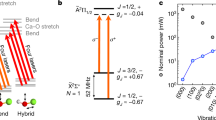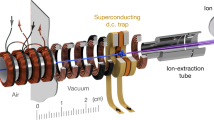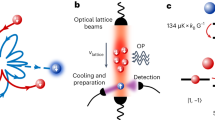Abstract
Recent advances1,2,3,4,5 in the magnetic trapping and evaporative cooling of atoms to nanokelvin temperatures have opened important areas of research, such as Bose–Einstein condensation and ultracold atomic collisions. Similarly, the ability to trap and cool molecules should facilitate the study of ultracold molecular physics and collisions6; improvements in molecular spectroscopy could be anticipated. Also, ultracold molecules could aid the search for electric dipole moments of elementary particles7. But although laser cooling (in the case of alkali metals1,8,9) and cryogenic surface thermalization (in the case of hydrogen10,11) are currently used to cool some atoms sufficiently to permit their loading into magnetic traps, such techniques are not applicable to molecules, because of the latter's complex internal energy-level structure. (Indeed, most atoms have resisted trapping by these techniques.) We have reported a more general loading technique12 based on elastic collisions with a cold buffer gas, and have used it to trap atomic chromium and europium13,14. Here we apply this technique to magnetically trap a molecular species—calcium monohydride (CaH). We use Zeeman spectroscopy to determine the number of trapped molecules and their temperature, and set upper bounds on the cross-sectional areas of collisional relaxation processes. The technique should be applicable to many paramagnetic molecules and atoms.
This is a preview of subscription content, access via your institution
Access options
Subscribe to this journal
Receive 51 print issues and online access
$199.00 per year
only $3.90 per issue
Buy this article
- Purchase on Springer Link
- Instant access to full article PDF
Prices may be subject to local taxes which are calculated during checkout



Similar content being viewed by others
References
Anderson, M. H., Ensher, J. R., Matthews, M. R., Wieman, C. E. & Cornell, E. A. Observation of Bose-Einstein condensation in a dilute atomic vapor. Science 269, 198–201 (1995).
Davis, K. B.et al. Bose–Einstein condensation in a gas of sodium atoms. Phys. Rev. Lett. 75, 3969–3973 (1995).
Bradley, C. C., Sackett, C. A. & Hulet, R. G. Bose-Einstein condensation of lithium: observation of limited condensate number. Phys. Rev. Lett. 78, 985–989 (1997).
Yu, I. A.et al. Evidence for universal quantum reflection of hydrogen from liquid 4He. Phys. Rev. Lett. 71, 1589–1592 (1993).
Wineland, D. J., Wieman, C. E. & Smith, S. J. (eds) Proc. 14th Int. Conf. (Am. Inst. Phys., New York, (1995)).
Balakrishnan, N., Forrey, R. C. & Dalgarno, A. Quenching of H2vibrations in ultracold 3He and 4He collisions. Phys. Rev. Lett. 80, 3224–3227 (1998).
Hinds, E. A. & Sangster, K. in Time-Reversal—The Arthur Rich Memorial Symposium (eds Skalsey, M., Bucksbaum, P. H., Conti, R. S. & Gidley, D. W.) 77–83 (Am. Inst. Phys., New York, (1993)).
Migdal, A. L., Prodan, J. V., Phillips, W. D., Bergeman, T. H. & Metcalf, H. J. First observation of magnetically trapped neutral atoms. Phys. Rev. Lett. 54, 2596–2599 (1985).
Ketterle, W. & Van Druten, N. J. Evaporative cooling of trapped atoms. Adv. At. Mol. Opt. Phys. 37, 181–236 (1996).
Hess, H. F.et al. Magnetic trapping of spin-polarized atomic hydrogen. Phys. Rev. Lett. 59, 672–675 (1987).
van Roijen, R., Berkhout, J. J., Jaakkola, S. & Walraven, J. T. M. Experiments with atomic hydrogen in a magnetic trapping field. Phys. Rev. Lett. 61, 931–934 (1988).
Doyle, J. M., Friedrich, B., Kim, J. & Patterson, D. Buffer-gas loading of atoms and molecules into a magnetic trap. Phys. Rev. A 52, R2515–R2518 (1995).
Kim, J.et al. Buffer-gas loading and magnetic trapping of atomic europium. Phys. Rev. Lett. 78, 3665–3668 (1997).
Weinstein, J. D.et al. Magnetic trapping of atomic chromium. Phys. Rev. A 57, R3173–R3175 (1998).
Hess, H. F. Evaporative cooling of magnetically trapped and compressed spin-polarized hydrogen. Phys. Rev. B 34, 3476–3479 (1986).
Masuhara, N.et al. Evaporative cooling of spin-polarized atomic hydrogen. Phys. Rev. Lett. 61, 935–938 (1988).
Bahns, J. T., Stwalley, W. C. & Gould, P. L. Laser cooling of molecules: a sequential scheme for rotation, translation, and vibration. J. Chem. Phys. 104, 9689–9697 (1996).
Cote, R. & Dalgarno, A. Mechanism for the production of vibrationally excited ultracold molecules of 7Li2. Chem. Phys. Lett. 279, 50–54 (1997).
Band, Y. B. & Julienne, P. S. Ultracold-molecule production by laser-cooled atom photoassociation. Phys. Rev. A 51, R4317–R4320 (1995).
Fioretti, A.et al. Formation of cold Cs2molecules through photoassociation. Phys. Rev. Lett. 80, 4402–4405 (1998).
Askar'yan, G. A. Effects of the gradient of a strong electromagnetic beam on electrons and atoms. Sov. Phys. JETP 15, 1088–1090 (1962).
Ashkin, A. Trapping of atoms by resonance radiation pressure. Phys. Rev. Lett. 40, 729–732 (1978).
Miller, J. D., Cline, R. a. & Heinzen, D. J. Far-off-resonance optical trapping of atoms. Phys. Rev. A 47, R3567–R4570 (1993).
Friedrich, B. & Herschbach, D. Alignment and trapping of molecules in intense laser fields. Phys. Rev. Lett. 74, 4623–4626 (1995).
Takekoshi, T., Patterson, B. M. & Knize, R. J. Phys. Rev. Lett. (submitted).
Petrich, W., Anderson, M. H., Ensher, J. R. & Cornell, E. A. Stable, tightly confining magnetic trap for evaporative cooling of neutral atoms. Phys. Rev. Lett. 74, 3352–3355 (1995).
Kim, J. Buffer-gas Loading and Magnetic Trapping of Atomic Europium.Thesis, Harvard Univ.((1997)).
Berg, L.-E. & Klynning, L. Rotational analysis of the A-X and B-X band systems of CaH. Physica Scripta 10, 331–336 (1974).
Martin, H. Laser spectroscopic investigations of the red band systems of CaH. J. Mol. Spectrosc. 108, 66–81 (1984).
Leininger, T. & Jeung, G. Ab initio calculation of rovibronic transition spectra of CaH. J. Chem. Phys. 103, 3942–3949 (1995).
Berg, L.-E., Ekvall, K. & Kelly, S. Radiative lifetime measurement of vibronic levels of the B2Σ+ state of CaH by laser excitation spectroscopy. Chem. Phys. Lett. 257, 351–355 (1996).
Acknowledgements
We thank R. Field for discussions on the theory of the Zeeman structure of CaH. This Letter is based on work supported by the US NSF; J.D.W. is supported by an NSF graduate research fellowship.
Author information
Authors and Affiliations
Rights and permissions
About this article
Cite this article
Weinstein, J., deCarvalho, R., Guillet, T. et al. Magnetic trapping of calcium monohydride molecules at millikelvin temperatures. Nature 395, 148–150 (1998). https://doi.org/10.1038/25949
Received:
Accepted:
Issue Date:
DOI: https://doi.org/10.1038/25949
This article is cited by
-
Magnetic trapping of ultracold molecules at high density
Nature Physics (2023)
-
Electronic and dynamical properties of non-covalent diatomic aggregates formed by He with neutral and ionic Li and Be
Journal of Molecular Modeling (2023)
-
Molecular collisions: From near-cold to ultra-cold
Frontiers of Physics (2021)
-
Collisional cooling of ultracold molecules
Nature (2020)
-
Collisions between cold molecules in a superconducting magnetic trap
Nature (2019)
Comments
By submitting a comment you agree to abide by our Terms and Community Guidelines. If you find something abusive or that does not comply with our terms or guidelines please flag it as inappropriate.



